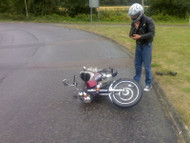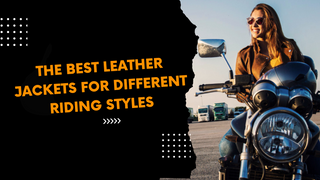Protect Yourself During a Motorcycle Crash
10th Aug 2015
A rebellious spirit operates to the beat of his own drum. When you put one on a smooth hood, with a gearshift, a clutch and a powerful machine underneath, there’s no stopping what could happen next.
The simple truth is: the reality of riding is dangerous. Even a small miscalculation at a parking lot, say dropping the bike, can break a rider’s bones to different places and cause irreparable damage to the motorcycle. Add speed and fearless daring to the equation, how much more in an open road? When both are more exposed and vulnerable.
It’s important to understand basic transport dynamics. There’s a reason why they call it accidents after all. As a biker, we have to come to terms with the fact that we can get hurt and we probably will regardless of whether we are careful than most or not.
What You Need To Know
AustralianAutomobile Association’s latest quarterly report indicates that there have been 201 motorcyclists killed on Australian roads in the past 12 months, an increase from 194 in the corresponding period for 2014.
On a separate report by RoadSafety Transport for NSW, there were 41,250 recorded road crashes in New South Wales in 2012. 369 persons killed and 22,932 injured.

Though the passion to ride comes with high price, most motorcycle crashes, if not all, are preventable. So here’s where the rubber meets the road. Have a look at some of the safety tips we’ve researched on and some we’ve experienced ourselves over the years below.
Don’t Drink and Ride
Being responsible means not deliberately putting yourself in harm’s way. With the annual average growth of 4%for motorcycle registrations, we can expect that there will be more riders on the road as the years go by. A large portion of motorcycle crashes happens on weekends, when there’s a good amount of social gathering and high probability of alcohol running in our system. We’ve seen this dozens of times in the news. Alcohol is and will always be a prominent evil in any type of vehicular accidents.
In the five years to 1987, more than 110 drivers and motorcycle riders that were killed each year had a Blood Alcohol Content (BAC) greater than 0.05g/100ml. This has dropped to an average of 40 drivers and riders killed each year over the last five years (2008-2012) with a BAC greater than 0.05g/100ml.
Another factor to consider is the weather. Assuming that other vehicles can’t see you is the best way to play it safe. Think about it. 4 tires can stop quicker than 2 tires. Anywhere in the world, the consistent rule of thumb is that when head-on collisions occur, the riders are usually at fault. Also, keep in mind that what you can’t see can hurt you as well. When fatigue takes over and visibility is at a minimum, making a stop somewhere and staying in for the night could be the best lifesaving decision you could make not just for yourself but for the people you care about waiting for you at home.
Wear Protective Motorcycle Gear
Always better to be safe now than sorry later. As you will be spending lots of time on the road, might as well be prepared for the unexpected. Helmets are the most important equipment you can wear. Choose one that you’re most comfortable with that can meet your riding needs. Next is eye protection. Eyewear is essential for protecting you from road debris and other hazards like small bugs that can jeopardize vision. Last but not the least is clothing. Protective gear basic ensemble should include durable long-sleeved jacket, full-fingered gloves, long pants and over-the-ankle boots. While this is not guaranteed to save you in a full impact crash, it gives you the best possible chance.
When it comes to jackets, remember that only a few fabrics can hold a candle to leather. We’ve heard several stories from those who wore proper gear and from those who unfortunately failed to. Make sure it has CE approved armour in the shoulders, elbows and back. We certainly don’t want you to be on the wrong side of the fence without these minimum protection.
The Riders Risk video by Motorcycle Council of NSW has great section on Protective Clothing and outcomes if not worn ( http://www.mccofnsw.org.au/a/335.html - WARNING GRAPHIC VIDEO)
Read on these real testaments from those who nearly lost their lives on the road and how their motorcyclejackets and gloves saved them:
I had an accident recently on my bike, I hit the road at 50-60kms and slid about 2 meters on my right side and I was wearing a Rhino Leather hoodie zip up jacket and gloves. Consequently I only received bruising as the armour inside this casual jacket saved my right arm from a serious injury.
- Marty V about Kevlar Hoodie
Just wanted you to know that one month ago I was involved in a very nasty bike verses car accident at high speed which nearly took my life. I've still got about two months in hospital and rehab. What I was going to say is that the Rhino leather jacket & gloves saved my life. Not much left of them and only ended up with a few small scratches. I broke a few bones but at least I didn't lose my skin.
-Peter S about Brando Braided Jacket
Unfortunately I had a bad accident and later told Rhino jacket saved my life from further internal injuries that I had received. My wife and kids made a deal with me, get one of your jackets again and they will let me ride.
- Paul M about Brando Braided Jacket with Vents
..dropped my bike at 60km's broke my shoulder, stuffed my helmet, $3,500 damage to the bike and all the jacket had was some very light scuffing on the shoulder and elbow.
- Ray G about Brando Jacket
Happy Riding!
Rhino Leather ensures that your time on motorcycle is hassle-free and fun, and you don’t have to worry about other elements or safety. Call us and get the best deal for a leather jacket today!
RhinoLeather ensures that your time on motorcycle is hassle-free and fun, and you don’t have to worry about other elements or safety. Call us and get the best deal for a leather jacket today!






